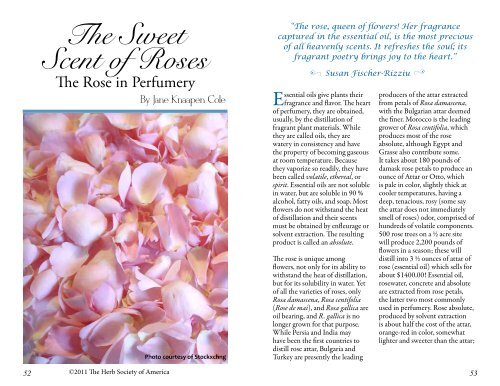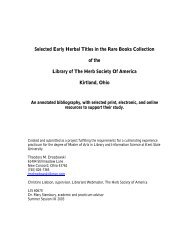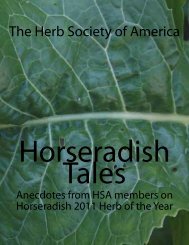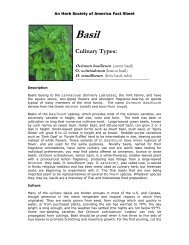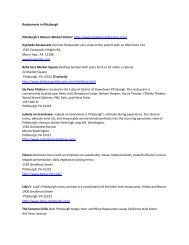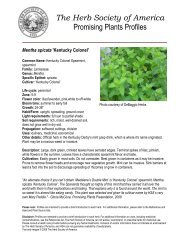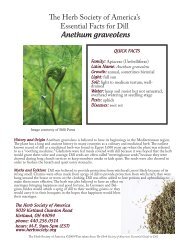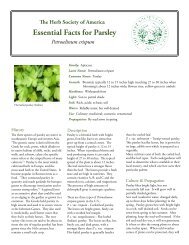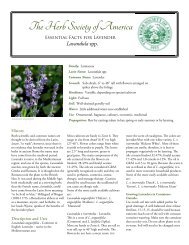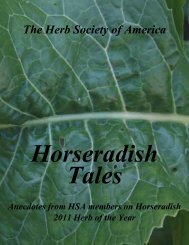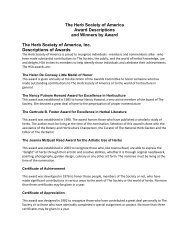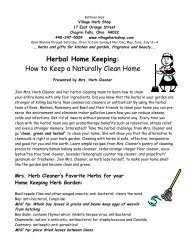The Sweet Scent of Roses - The Herb Society of America
The Sweet Scent of Roses - The Herb Society of America
The Sweet Scent of Roses - The Herb Society of America
You also want an ePaper? Increase the reach of your titles
YUMPU automatically turns print PDFs into web optimized ePapers that Google loves.
52<br />
<strong>The</strong> <strong>Sweet</strong><br />
<strong>Scent</strong> <strong>of</strong> <strong>Roses</strong><br />
<strong>The</strong> Rose in Perfumery<br />
By Jane Knaapen Cole<br />
Photo courtesy <strong>of</strong> Stockxchng<br />
“<strong>The</strong> rose, queen <strong>of</strong> flowers! Her fragrance<br />
captured in the essential oil, is the most precious<br />
<strong>of</strong> all heavenly scents. It refreshes the soul; its<br />
fragrant poetry brings joy to the heart.”<br />
y Susan Fischer-Rizziuy<br />
Essential oils give plants their<br />
fragrance and flavor. <strong>The</strong> heart<br />
<strong>of</strong> perfumery, they are obtained,<br />
usually, by the distillation <strong>of</strong><br />
fragrant plant materials. While<br />
they are called oils, they are<br />
watery in consistency and have<br />
the property <strong>of</strong> becoming gaseous<br />
at room temperature. Because<br />
they vaporize so readily, they have<br />
been called volatile, ethereal, or<br />
spirit. Essential oils are not soluble<br />
in water, but are soluble in 90 %<br />
alcohol, fatty oils, and soap. Most<br />
flowers do not withstand the heat<br />
<strong>of</strong> distillation and their scents<br />
must be obtained by enfleurage or<br />
solvent extraction. <strong>The</strong> resulting<br />
product is called an absolute.<br />
<strong>The</strong> rose is unique among<br />
flowers, not only for its ability to<br />
withstand the heat <strong>of</strong> distillation,<br />
but for its solubility in water. Yet<br />
<strong>of</strong> all the varieties <strong>of</strong> roses, only<br />
Rosa damascena, Rosa centifolia<br />
(Rose de mai), and Rosa gallica are<br />
oil bearing, and R. gallica is no<br />
longer grown for that purpose.<br />
While Persia and India may<br />
have been the first countries to<br />
distill rose attar, Bulgaria and<br />
Turkey are presently the leading<br />
producers <strong>of</strong> the attar extracted<br />
from petals <strong>of</strong> Rosa damascena,<br />
with the Bulgarian attar deemed<br />
the finer. Morocco is the leading<br />
grower <strong>of</strong> Rosa centifolia, which<br />
produces most <strong>of</strong> the rose<br />
absolute, although Egypt and<br />
Grasse also contribute some.<br />
It takes about 180 pounds <strong>of</strong><br />
damask rose petals to produce an<br />
ounce <strong>of</strong> Attar or Otto, which<br />
is pale in color, slightly thick at<br />
cooler temperatures, having a<br />
deep, tenacious, rosy (some say<br />
the attar does not immediately<br />
smell <strong>of</strong> roses) odor, comprised <strong>of</strong><br />
hundreds <strong>of</strong> volatile components.<br />
500 rose trees on a ½ acre site<br />
will produce 2,200 pounds <strong>of</strong><br />
flowers in a season; these will<br />
distill into 3 ½ ounces <strong>of</strong> attar <strong>of</strong><br />
rose (essential oil) which sells for<br />
about $1400.00! Essential oil,<br />
rosewater, concrete and absolute<br />
are extracted from rose petals,<br />
the latter two most commonly<br />
used in perfumery. Rose absolute,<br />
produced by solvent extraction<br />
is about half the cost <strong>of</strong> the attar,<br />
orange-red in color, somewhat<br />
lighter and sweeter than the attar;<br />
©2011 <strong>The</strong> <strong>Herb</strong> <strong>Society</strong> <strong>of</strong> <strong>America</strong> 53
Today, rose history continues to evolve. Wonderful new varieties are<br />
available and several <strong>of</strong> the much-loved older ones still grace gardens<br />
throughout the world. Rose lovers have banded together in rose<br />
societies that are dedicated solely to the promotion <strong>of</strong> this famous<br />
flower. <strong>The</strong> rose industry continues to prosper and grow. This highly<br />
esteemed botanical treasure has played an integral role in the past and<br />
will continue to do so in the future.<br />
References<br />
1. Goody, Jack. 1993. <strong>The</strong> culture <strong>of</strong> flowers. New York: Cambridge<br />
University Press.<br />
2. Hunt, Lynn. 2011. “<strong>Roses</strong>: new research raises questions about their<br />
history. Christian Science Monitor, Feb. 7.<br />
http://www.csmonitor.com/<strong>The</strong>-Culture/Gardening/digginit/2011/0207/<strong>Roses</strong>-New-research-raises-questions-about-theirhistory/%28page%29/2<br />
(accessed August 22, 2011).<br />
3. Johnson, Murrie Alice. 1998. “Collection <strong>of</strong> Historical Vignettes.”<br />
Lowcountry Rose <strong>Society</strong> (CLRS) <strong>of</strong> South Carolina Newsletter.<br />
50<br />
Did you Know?<br />
❉ Some say the Rosary derived its name from rose hips,<br />
which were strung as prayer beads by the monks. Later,<br />
rosary beads were formed from the fragrant paste <strong>of</strong><br />
crushed rose petals.<br />
❉ Attar <strong>of</strong> Rose was one <strong>of</strong> the most prized perfumes<br />
<strong>of</strong> the ancient world. Attar is the essential oil extracted<br />
from rose petals through the distillation process and<br />
it takes several hundred pounds <strong>of</strong> petals for just a few<br />
ounces <strong>of</strong> oil.<br />
Romans, rose was the favorite:<br />
this was the strongly scented<br />
Rosa gallica, or Rosa damascena,<br />
(an historic hybrid <strong>of</strong> R. gallica<br />
and R. Phoenicia). Rose petals<br />
stuffed pillows and cushions, were<br />
strewn at banquets and public<br />
ceremonies, flavored food, drink,<br />
medicine and love potions. Nero<br />
once had silver pipes installed<br />
under each plate so guests would<br />
be spritzed with rosewater<br />
between courses. Pliny the Elder<br />
(23-79 A.D.), wrote <strong>of</strong> the plants<br />
grown, spices and aromatics<br />
imported, and the perfumes made<br />
in Rome. He tells us Roman<br />
aromaterii made three types <strong>of</strong><br />
perfumes: solid unguents usually<br />
<strong>of</strong> a single fragrance in lard; liquid<br />
unguents, a mixture <strong>of</strong> flowers,<br />
spices and resin in a base <strong>of</strong> olive<br />
or sesame oil, sometimes colored<br />
with alkanet or cinnebar; and<br />
scented powders for sprinkling in<br />
clothes. Both he and Dioscorides<br />
listed a number <strong>of</strong> diseases that<br />
were treated with roses. Galen left<br />
his recipe for a cleansing cream<br />
containing beeswax, oil <strong>of</strong> roses,<br />
water and spirit <strong>of</strong> vinegar; this<br />
combination has lasted through<br />
the centuries as cold cream, with<br />
vegetable oils replacing the attar<br />
<strong>of</strong> rose oil.<br />
Persia is credited with inventing<br />
the distillation process and<br />
Ibn-Sina (980-1037), with<br />
improvements in the technique <strong>of</strong><br />
distillation. He tells us roses were<br />
Oil-Bearing<br />
<strong>Roses</strong><br />
Top to bottom: Rosa damascena,<br />
Rosa centifolia, Rosa gallica<br />
Photos courtesy <strong>of</strong> Wikimedia<br />
Commons<br />
©2011 <strong>The</strong> <strong>Herb</strong> <strong>Society</strong> <strong>of</strong> <strong>America</strong> 55
Later European monarchs wanted roses. Empress Josephine <strong>of</strong> France<br />
(ca. 1763-1814) was a true patron <strong>of</strong> roses and was said to have had<br />
more than 200 different roses growing in her gardens. Botanists grew<br />
and hybridized roses in the 1800s; good qualities <strong>of</strong> fragrance, long<br />
bloom times, and disease resistance were valued even then.<br />
English collectors and botanists, John Tradescant (ca. 1570s-1638)<br />
the elder and his son John Tradescant (ca. 1608-1662) the younger,<br />
travelled the world collecting new and unusual plants. <strong>The</strong>y introduced<br />
several new species <strong>of</strong> roses to England as well as other plants such as<br />
poppies, phlox, and geraniums (2). <strong>The</strong> plant genus Tradescantia is<br />
named in honor <strong>of</strong> them. <strong>The</strong> English shrub rose Trandescant (Rosa<br />
‘Ausdir’ Tradescant) is named after the Tradescant Trust (2).<br />
One <strong>of</strong> the oldest garden roses is the apothecary rose, Rosa gallica<br />
‘Officinalis,’ sometimes referred to as the Provins rose because it has<br />
been grown commercially in Provins, France for centuries. Doctors<br />
and apothecaries believed that this rose could help cure a multitude <strong>of</strong><br />
illnesses. Since many <strong>of</strong> their patients could not read, they painted a red<br />
rose on the signs outside <strong>of</strong> their shop to advertise that they were in the<br />
business <strong>of</strong> healing and medicine.<br />
Rosa gallica<br />
Photo by Javier Martin/Wikimedia Commons<br />
powders (to use on wigs and hair)<br />
grew in use among aristocrats,<br />
until they became quite common<br />
during the reign <strong>of</strong> Louis XIV<br />
(1638-1755), whose perfumer, M.<br />
Marietal, created a new scent for<br />
him every day! Grasse has since<br />
become the center <strong>of</strong> the perfume<br />
world.<br />
England was also creating<br />
fragrances during this period.<br />
Most castles and manor houses<br />
had stillrooms where the ladies<br />
<strong>of</strong> the manor distilled floral and<br />
herbal waters, as not everyone<br />
could afford imported perfumes.<br />
Rose, lavender, and violet were<br />
the favorite flowers to use. <strong>The</strong>se<br />
floral waters were also used to<br />
scent salves, lotions and various<br />
medicinal potions. Nostradamus<br />
prescribed roses to treat the<br />
plague; in the sixteenth and<br />
seventeenth centuries, they were<br />
used to treat many ailments.<br />
While the French Revolution had<br />
put a stop to the production <strong>of</strong><br />
perfumes and other luxuries in<br />
France, when Napoleon became<br />
emperor these industries started<br />
to emerge once more. He was<br />
fastidious about cleanliness,<br />
washing daily and using several<br />
bottles <strong>of</strong> Eau de Cologne a day.<br />
His wife, Josephine, remembered<br />
for the rose garden she created at<br />
her chateau at Malmaison, was<br />
also noted for her cultivation <strong>of</strong><br />
fashion and use <strong>of</strong> perfumes.<br />
<strong>The</strong> Glittering Second Empire<br />
saw the rise <strong>of</strong> some <strong>of</strong> the great<br />
perfume houses: Guerlain, Worth,<br />
Pinaud. Guerlain changed the way<br />
perfume was made by focusing<br />
on the philosophy <strong>of</strong> the scent,<br />
attempting to evoke a mood<br />
or atmosphere. L’Heure Bleue,<br />
inspired by the hour just before<br />
sunset, uses rose, iris, musk and<br />
vanilla, while Shalimar conjures<br />
up a Mogul garden.<br />
<strong>The</strong> early twentieth century<br />
became the golden age <strong>of</strong><br />
perfumery becoming linked to<br />
the fashion industry. In 1900,<br />
Houbigant introduced Ideale,<br />
the first perfume to contain<br />
20% <strong>of</strong> the Bulgarian rose attar.<br />
Rose Jacqueminot by Coty, Rose<br />
d’Orsay, and Guerlain Rose<br />
followed. While blended flower<br />
perfumes have replaced these<br />
single flowered ones, the rose is<br />
still an essential element in many<br />
perfumes including Shalimar,<br />
Chanel #5, Arpege, Joy, White<br />
Linen, Anaïs Anaïs, Beautiful,<br />
Lauren and Opium.<br />
In ancient times, perfumes were<br />
precious: mystical, magical, used<br />
for worship, aphrodisiacs and<br />
healing. <strong>The</strong> ancient Persian<br />
pharmacopoeia listed hundreds <strong>of</strong><br />
perfumed treatments for healing.<br />
<strong>The</strong> Chinese said “Every perfume<br />
is a medicine”. This is more than a<br />
charming statement: essential oils<br />
are antiseptic and bactericidal. <strong>The</strong><br />
48 ©2011 <strong>The</strong> <strong>Herb</strong> <strong>Society</strong> <strong>of</strong> <strong>America</strong><br />
57
<strong>Roses</strong><br />
Throughout<br />
History<br />
46<br />
By Lorraine Kiefer<br />
Photo courtesy <strong>of</strong> Stockxchng<br />
movement begun by chemists<br />
and doctors in France at the<br />
beginning <strong>of</strong> the twentieth<br />
century proved that and resulted<br />
in the beginning <strong>of</strong> Aromatherapy.<br />
According to aromatherapist<br />
Salvatore Battaglia, rose essential<br />
oil is a good tonic and fortifier<br />
for heart, liver and gall bladder;<br />
has a soothing action on nerves,<br />
headaches and dyspepsia; and<br />
is anti-depressive. Its emollient,<br />
hydrating, antiseptic qualities<br />
make it ideal in skin care especially<br />
for dry, sensitive or mature skin.<br />
Rose Otto is considered the more<br />
‘therapeutic’—mostly because the<br />
absolute may contain traces <strong>of</strong> the<br />
solvent. Rose is considered the<br />
premier essential oil for opening the<br />
heart chakra. It is harmonizing,<br />
balancing, helps soothe anger, fear<br />
and anxiety; it restores confidence.<br />
Bibliography<br />
1. Barillé, Elisabeth and Laroze<br />
Catherine. <strong>The</strong> Book <strong>of</strong> Perfume. Paris-<br />
New York:Flammarion. 1995.<br />
2. Battaglia, Salvatore. <strong>The</strong> Complete<br />
Guide to Aromatherapy. Australia:<strong>The</strong><br />
Perfect Potion, 1995.<br />
3. Cole, Jane. “<strong>The</strong> History <strong>of</strong><br />
Fragrance.” <strong>The</strong> <strong>Herb</strong>arist. 2006.<br />
4. Fisher, John. <strong>The</strong> Companion to<br />
<strong>Roses</strong>. New York-Great Britain:Viking<br />
Press, 1986.<br />
5. Groom, Nigel. <strong>The</strong> Perfumers<br />
Handbook. London:Chapman and<br />
Hall, 1992.<br />
6. Manniche, Lise. Sacred Luxuries.<br />
Ithaca, New York:Cornell University<br />
Press, 1999.<br />
7. Morris, Edwin. Fragrance. New<br />
York:Charles Scribner’s Sons, 1984.<br />
8. Wildwood, Christine. Creative<br />
Aromatherapy. Thorsons/An<br />
Imprint <strong>of</strong> Harper Collins:London-<br />
San Francisco, 1993.<br />
Jane Knaapen Cole is<br />
a member at large and a member<br />
<strong>of</strong> HSA’s Rosemary Circle. She has<br />
written articles for <strong>The</strong> <strong>Herb</strong>arist.<br />
Jane spends half the year in DePere,<br />
WI, and, gratefully, the winter half<br />
in Mesa, AZ. She continues to<br />
present herb programs and helps to<br />
plant and tend the herb gardens at<br />
the Green Bay Botanical Garden<br />
and Historic Hazelwood.<br />
©2011 <strong>The</strong> <strong>Herb</strong> <strong>Society</strong> <strong>of</strong> <strong>America</strong> 59
Rose Etymology<br />
By Rex Talbert<br />
O.E. rose, from L. rosa (cf. It., Sp. rosa, Fr. rose; also source <strong>of</strong><br />
Du. roos, Ger. Rose, Swed. ros, etc.), probably via Italian and Greek<br />
dialects from Gk. rhodon “rose” (Aeolic wrodon), ultimately from<br />
Pers. *vrda-. But cf. Tucker: “<strong>The</strong> rose was a special growth <strong>of</strong> Macedonia<br />
and the Thracian region as well as <strong>of</strong> Persia, and the Lat. and Gk. names<br />
prob. came from a Thraco-Phrygian source.” Aramaic warda is from O.<br />
Persian; the modern Persian cognate, via the usual sound changes, is gul,<br />
source <strong>of</strong> Turk. gül “rose.” <strong>The</strong> ultimate source <strong>of</strong> all this may be PIE *wrdho-<br />
“thorn, bramble.”<br />
<strong>The</strong> preceding paragraph is a direct quote from the Online Etymological<br />
Dictionary and represents the typically expressed conclusions <strong>of</strong> our day<br />
on the etymological focus for the English word rose. This examination<br />
<strong>of</strong> the journey <strong>of</strong> a word from one language to another is naturally<br />
highly time-sequence dependent and is replete with guesses and<br />
assumptions as noted in the quote above. <strong>The</strong> notation * as in “*vrda”<br />
indicates one <strong>of</strong> the larger presumptions in the word origin logic as it is<br />
a linguistics symbol for a hypothetical word not a recorded word. To be<br />
practical then, every comment after this symbol should be considered in<br />
a more suspect light.<br />
Other possibilities such as a totally separate path for the word rose<br />
should be considered. <strong>The</strong> Mycenaean word frodon, the oldest recorded<br />
word for rose, predates the Old Persian vrda and compares well with<br />
its contemporary Aeolic word wrodon and the subsequent Greek word<br />
rhodon. This logic would encourage us to look no farther than the<br />
ancient Greeks.<br />
44<br />
‘Stat rosa pristina nomine, nomina nuda tenemus’<br />
Making Rose<br />
Beads<br />
By Susan Belsinger<br />
© Steve Weaver | Dreamstime.com<br />
©2011 <strong>The</strong> <strong>Herb</strong> <strong>Society</strong> <strong>of</strong> <strong>America</strong> 61
Periodic Fertilization<br />
To nourish beneficial soil organisms, strengthen the immune system,<br />
and combat the stresses <strong>of</strong> heat, urban pollution, pests and diseases,<br />
fertilization should be done every four to six weeks during the growing<br />
season, stopping in late summer.<br />
• Plant growth activators that contain beneficial soil bacteria<br />
• Seaweed organic fertilizer which contains kelp, vitamins,<br />
chelated micronutrients, fungi and humic acid<br />
Pest Removal<br />
• Remove aphids with a hard spray <strong>of</strong> cold water<br />
Rose Pruning<br />
First, determine if the rose blooms on old or on new wood. <strong>Roses</strong><br />
that bloom on old wood include many <strong>of</strong> the species roses and the old<br />
European roses. <strong>The</strong>se are pruned more lightly in late winter. <strong>Roses</strong> such<br />
as teas, chinas, and some new shrub roses, bloom on new growth and<br />
can therefore tolerate a harder prune.<br />
When roses are first planted they require minimal pruning. Once<br />
established, try to keep three different years <strong>of</strong> growth—current, 1-year<br />
old, 2-year old branches.<br />
• Prune all dead, diseased, crossing and weak branches first<br />
and then step back to see what remains<br />
• <strong>The</strong> best time to prune is in late winter just when the buds<br />
are beginning to swell, but at least one month prior to<br />
the last frost<br />
• Cut on an angle, just above the buds that face the direction<br />
<strong>of</strong> desired growth (usually away from the plant). Do the<br />
same when deadheading.<br />
accomplishing much. In just a few hours, large amounts <strong>of</strong> mash are<br />
kneaded, measured, rolled, and placed on wires to dry. <strong>The</strong> fun that<br />
we’re having, the camaraderie, and the shared belief in the value <strong>of</strong> our<br />
purpose keeps us turning out beads by the hundreds.<br />
We all have our roles. Some are mash makers or bead rollers, others<br />
design or package the jewelry, everyone tries her hand at stringing the<br />
beads, and some dabble in all aspects <strong>of</strong> production.<br />
At a workshop, we all work carefully. Any bead that dries imperfectly is<br />
rejected—placed back in the mash pot and cooked down again—and<br />
any string with a bead out <strong>of</strong> place is disassembled and restrung. We<br />
mean business: we’re creating works <strong>of</strong> art. From mail-order businesses,<br />
gem shows, and local bead shops, members buy and collect other beads<br />
to string along with the rose beads for a greater variety in design and<br />
colors in the finished necklaces.<br />
<strong>The</strong> rose-bead project has become a way <strong>of</strong> life for many members <strong>of</strong><br />
our group. Some women roll the mash or string the beads as they watch<br />
television or listen to music in the evenings. Our families put up with<br />
freezers and attics full <strong>of</strong> rose petals, pots bubbling on the stove for days<br />
on end, mothers and wives with blackened hands, not to mention the<br />
sometimes overwhelming fragrance. We still laugh to think <strong>of</strong> Mary<br />
Jane Miller’s poor husband, who took a big taste out <strong>of</strong> a steaming pot,<br />
thinking it was dinner.<br />
With this project, the Potomac Unit reclaims a lost art. <strong>The</strong> beads let us<br />
combine a passion for flowers with an appreciation <strong>of</strong> beautiful jewelry.<br />
A bonus is that the fragrance <strong>of</strong> roses is always with us.<br />
Part <strong>of</strong> the Ruth Smith Botanical Bead Collection<br />
Photo courtesy <strong>of</strong> HSA Archives<br />
42 ©2011 <strong>The</strong> <strong>Herb</strong> <strong>Society</strong> <strong>of</strong> <strong>America</strong><br />
63
Recommendations for <strong>Roses</strong> that can<br />
be Grown Sustainably<br />
‘Blanc Double de Coubert’<br />
Low, open habit, fragrant, coarse foliage<br />
‘Carefree Beauty’<br />
Large, loose, semi-double pink, light fragrance, Minor black spot<br />
‘Graham Thomas’<br />
A solid performer, good fragrance, interesting butterscotch color<br />
‘Heritage’<br />
Always nice, pink, double, very fragrant<br />
‘Louise Odier’<br />
Wonderful fragrance, old-fashioned double pink<br />
‘Marie Pavie’<br />
A nice small plant with gorgeous, fragrant flowers<br />
‘Mrs. Dudley Cross’<br />
Nice blend, loosely double, good rebloom<br />
R. chinensis v. mutabilis<br />
Lovely, everblooming shrub or climber in warmer areas<br />
‘Roseraie del ’Hay’<br />
Magenta flowers, fragrant, thorny, informal habit <strong>of</strong> rugosa roses<br />
‘Spice’<br />
A small plant, double pink flowers<br />
‘<strong>The</strong> Pilgrim’<br />
Pale yellow, double flowers, good repeat bloom<br />
Photos on opposite page courtesy Holly Shimizu<br />
Rose Bead Instructions<br />
Our recipe makes about seventy-five smooth black beads, or about<br />
enough for one necklace (more if other kinds <strong>of</strong> beads are added for<br />
accent). <strong>The</strong> batch is easily doubled or even tripled.<br />
Materials<br />
• 2–3 quarts clean rose petals<br />
• Large stainless-steel pot<br />
• Water<br />
• Blender or food processor<br />
• Jelly bag or cheesecloth<br />
• Iron pot or skillet<br />
• Rubber gloves<br />
• Tray<br />
• Newspapers<br />
• Paper towels<br />
• Rose essence<br />
• Plastic containers with tight-fitting lids<br />
• 1/2-teaspoon measuring spoon<br />
• Butter paddles (optional)<br />
• 3/64-inch brass wire, cut into 12-inch lengths<br />
• Empty small box or Styr<strong>of</strong>oam tray<br />
• Glass jars with lids<br />
• Fine sandpaper<br />
• Unwaxed dental floss<br />
• Assortment <strong>of</strong> other kinds <strong>of</strong> beads, if desired<br />
40 ©2011 <strong>The</strong> <strong>Herb</strong> <strong>Society</strong> <strong>of</strong> <strong>America</strong><br />
65
At the U.S. Botanic Garden we have been refining the art and<br />
science <strong>of</strong> growing healthy roses organically—this was thought to<br />
be an oxymoron, but we have shown that it is possible. This article is<br />
based on our current practices.<br />
A sustainable approach to rose growing is important for the health <strong>of</strong><br />
the environment as well as for pollinators. Using performance as the<br />
basis for choosing which roses to grow, together with great horticultural<br />
practices, allows for the opportunity to have healthy roses without the<br />
application <strong>of</strong> fungicides and insecticides. This is done by promoting<br />
vigorous growth and a strong immune system. <strong>The</strong> first step is to know<br />
the basic needs for growing roses:<br />
• At least six hours <strong>of</strong> direct sunlight<br />
• Minimal root competition from nearby trees<br />
• A soil pH <strong>of</strong> approximately 6.5<br />
• Good air circulation as a disease preventative<br />
• Rose roots grow deep (2-3’) and prefer a deeply dug soil<br />
with ample organic matter<br />
Although many great roses can be found in old cemeteries and<br />
abandoned sites and then selected for gardens, giving added attention to<br />
roses can help them look their best. Hardiness varies greatly with type,<br />
and frost protection is a must for roses whose cold tolerance is marginal<br />
for your area. It is best to grow roses on their own roots. If the plants are<br />
grafted, keep the bud union (the place where canes join the rootstock)<br />
just above the soil level. Plant bare root roses in late winter while the<br />
plants are still dormant. Potted roses can go in the ground in spring or<br />
fall, but need shelter from extreme weather.<br />
Photos courtesy Holly Shimizu<br />
You can make beads now or store the mash. To store, pack the mash into<br />
plastic containers with tight-fitting lids and refrigerate for as long as a<br />
week or freeze for a few months. <strong>The</strong> mash can be thawed and refrozen<br />
as necessary.<br />
Rolling:<br />
For each bead, measure out a slightly rounded ½ teaspoon <strong>of</strong> mash: the<br />
bead will shrink to about one-third its original size as it dries. Wearing<br />
gloves, knead each piece <strong>of</strong> mash in the palm <strong>of</strong> your hand to make sure<br />
it is smooth (remove any thorns or debris). With firm, even pressure,<br />
roll each bead between your palms until it is round. If the beads show<br />
any cracks while you’re rolling, dip the beads in a little water or rubbing<br />
alcohol and smooth them out, as the cracks will become bigger as the<br />
beads dry. Our group adds a textured pattern to the beads by gently but<br />
firmly rolling them between two textured butter paddles.<br />
Drying:<br />
Carefully slide the beads onto wires to dry. <strong>The</strong> wire should pierce the<br />
center <strong>of</strong> each bead. We use brass wires because brass doesn’t rust. We<br />
place about ten beads on each 12-inch wire, making sure that the beads<br />
don’t touch each other. Lay the wires across the empty box or styr<strong>of</strong>oam<br />
tray so that the beads are suspended and do not touch the bottom <strong>of</strong> the<br />
container.<br />
Keep the beads at room temperature and away from any drafts. If the<br />
beads dry too fast, they will crack; if it is cold or damp, they may mold.<br />
During the first week, turn the beads daily, sliding them back and forth<br />
a little on the wire to keep them from sticking. Leave the beads on the<br />
wires for another week or two, or until they are completely dry. Remove<br />
the dry beads from the wires and store them in tightly covered glass jars,<br />
which help retain their perfume until you’re ready to string them. After<br />
removing a batch <strong>of</strong> rose beads, we sand the wires with fine sandpaper to<br />
smooth them in preparation for the next workshop.<br />
38 ©2011 <strong>The</strong> <strong>Herb</strong> <strong>Society</strong> <strong>of</strong> <strong>America</strong><br />
67
Henry Flowers is a native<br />
Texan and graduated from Texas A&M<br />
University in 1991 with a Bachelor <strong>of</strong><br />
Science degree in Horticulture and in<br />
1993, with a Master <strong>of</strong> Agriculture degree<br />
in Floriculture. Upon graduation he began<br />
work with the Antique Rose Emporium,<br />
helping to design, implement, and manage<br />
retail nurseries in Independence and<br />
San Antonio, Texas and in Georgia. He<br />
is currently the Garden Director at the Round Top Festival-Institute in<br />
Round Top,Texas, where, with the help <strong>of</strong> many volunteers, he oversees the<br />
gardens and collections <strong>of</strong> herbs. He is a member <strong>of</strong> <strong>The</strong> <strong>Herb</strong> <strong>Society</strong> <strong>of</strong><br />
<strong>America</strong>, Pioneer Unit and oversees the annual <strong>Herb</strong>al Forum at Round<br />
Top, a joint production by the Pioneer Unit and the Festival-Institute. He<br />
is the 2009 recipient <strong>of</strong> the <strong>Herb</strong> <strong>Society</strong> <strong>of</strong> <strong>America</strong>’s Joanna McQuail<br />
Reed Award for the Artistic Use <strong>of</strong> <strong>Herb</strong>s.<br />
36<br />
Photos used in this article are courtesy <strong>of</strong> Henry Flowers<br />
Rose Alle with Thyme<br />
Rose Elixar,Tincture,<br />
and Vinegar<br />
By Gayle Engels<br />
Photo courtesy <strong>of</strong> Justus Kinderman<br />
©2011 <strong>The</strong> <strong>Herb</strong> <strong>Society</strong> <strong>of</strong> <strong>America</strong> 69
Floribundas are somewhat<br />
similar to the Polyanthas, but are<br />
<strong>of</strong>ten a bit bigger in stature and<br />
flower. Most are not known for<br />
fragrance, but are instead known<br />
for their showiness. <strong>The</strong>y are<br />
wonderful for mass plantings, for<br />
large containers, and as shrubs for<br />
smaller gardens. Some examples<br />
are ‘Grüss an Aachen’, ‘Kirsten<br />
Poulsen’, and ‘Betty Prior’.<br />
<strong>The</strong> Rugosa roses are descended<br />
from Rosa rugosa, which is native<br />
to Japan and the east coast<br />
<strong>of</strong> Asia. <strong>The</strong> class is generally<br />
marked by crinkly leaves (thus<br />
its specific epithet), fragrant<br />
blossoms which repeat bloom in<br />
the more modern hybrids, and<br />
most are very prickly and sturdy<br />
shrubs. <strong>The</strong>y are generally very<br />
cold hardy, carefree, and more<br />
salt tolerant than most roses;<br />
they can be found naturalized on<br />
beaches in the Pacific Northwest,<br />
Alaska, and in New England.<br />
Many cultivars are also known<br />
to produce very large and<br />
showy hips. Some well-known<br />
species forms and cultivars are<br />
Rosa rugosa alba and rubra,<br />
‘Belle Poitevine’, ‘Fru Dagmarr<br />
Hartopp’, ‘Grootendorst<br />
Supreme’, ‘Hansa’, and ‘Rose à<br />
Parfum de l’Hay’.<br />
Hybrid Musk roses are mainly<br />
the creation <strong>of</strong> one man, the<br />
Reverend Joseph Pemberton <strong>of</strong><br />
Essex. In the early 20th century<br />
he crossed the rose ‘Trier’, having<br />
blood from Rosa multiflora and<br />
the Noisette ‘Reve d’Or’, with<br />
other roses to create this new<br />
class. <strong>The</strong> Hybrid Musks are<br />
generally lax, arching shrubs<br />
or short climbers, with good<br />
remontancy and large clusters<br />
<strong>of</strong> richly scented blossoms. <strong>The</strong><br />
scent is <strong>of</strong>ten a heavy musk<br />
which can be traced to the Rosa<br />
multiflora and more distant Rosa<br />
moschata heritage. Many <strong>of</strong> the<br />
class are a bit more shade tolerant<br />
than most roses and this, along<br />
with their natural lax habit,<br />
makes them popular for informal,<br />
less-structured gardens. Popular<br />
cultivars include ‘Penelope’,<br />
‘Prosperity’, ‘Cornelia’, and ‘Buff<br />
Beauty’.<br />
Large Flowered Climbers<br />
and Ramblers are two classes<br />
<strong>of</strong> long-caned roses. No rose is<br />
truly a climber in the vein <strong>of</strong><br />
vines such as grapes, wisteria, or<br />
clematis, but they can be trained<br />
onto trellises and other structures<br />
or may naturally pull themselves<br />
up into trees, shrubs, or other<br />
structures by sending canes<br />
upwards and then using their<br />
prickles like grappling hooks<br />
to hold on. <strong>The</strong>re are climbing<br />
versions <strong>of</strong> roses in almost all<br />
rose classes—climbing Bourbons,<br />
Chinas, Teas, Noisettes, and so<br />
on.<br />
should contain at least one<br />
active ingredient. Rose elixirs,<br />
specifically, are good externally<br />
for reducing the pain <strong>of</strong> burns and<br />
speeding their healing, relieving<br />
the itch <strong>of</strong> insects stings and<br />
bites, for rashes caused by contact<br />
dermatitis, and as a liniment for<br />
nerve pain and sore muscles. All in<br />
all, rose elixir is an effective topical<br />
first aid treatment, and even more<br />
so when combined with other<br />
herbs suitable to the condition in<br />
question.<br />
Internally, rose elixir can be used<br />
to relieve stress, panic, trauma, or<br />
fear in both adults and children, as<br />
well as animals. <strong>The</strong> elixir acts as a<br />
nervine, calming without sedating.<br />
While rose tincture can be used in<br />
basically the same way, rose elixir<br />
tastes sweeter and is therefore<br />
more palatable than an alcohol<br />
tincture.<br />
<strong>The</strong> best roses to use are the old<br />
roses, <strong>of</strong>ten called heirloom or<br />
antique. All roses are not created<br />
equal. While the hybrids may<br />
have large, pretty, blooms and<br />
long stems making them suitable<br />
for cutting, they have lost much<br />
<strong>of</strong> their medicinal value through<br />
hybridization. Thus, the best<br />
roses to use include Rosa gallica<br />
(apothecary rose, called thus due<br />
either to its long medicinal use<br />
and/or because it was frequently<br />
planted outside apothecary<br />
shops), R. rugosa (rugose rose),<br />
R. canina (dog rose), R. centifolia<br />
(cabbage rose), R eglanteria<br />
(sweetbriar rose), or R. alba<br />
(white rose).<br />
Only use rose petals that have<br />
experienced no chemical<br />
interventions (fertilizer,<br />
insecticide, or herbicide) on the<br />
plants themselves or in the area.<br />
Use roses you’ve grown yourself or<br />
ones from a trusted source whom<br />
you know has grown their roses<br />
organically.<br />
Collect the petals when the<br />
flowers first open, preferably in<br />
early morning when the dew is on<br />
them. Use only perfect petals with<br />
no spots or other imperfections.<br />
If they are damp, spread them out<br />
in an airy place out <strong>of</strong> the sun to<br />
allow them to dry a little. Fresh<br />
petals are preferable; you can use<br />
dried petals in a pinch but you will<br />
need twice as many to make your<br />
infusion.<br />
Photo courtesy <strong>of</strong> Stockxchng<br />
©2011 <strong>The</strong> <strong>Herb</strong> <strong>Society</strong> <strong>of</strong> <strong>America</strong><br />
34 71
<strong>The</strong>y were brought from China<br />
on ships carrying tea and are<br />
said to have a tea-like aroma<br />
(arguable)—thus the name <strong>of</strong><br />
the class. In general they are large<br />
shrubs with rich burgundy new<br />
growth, are quite remontant, love<br />
heat, have large and lax flowers,<br />
and are mostly in pastel shades<br />
<strong>of</strong> red, yellow, pink, and white.<br />
<strong>The</strong> yellow coloration <strong>of</strong> many<br />
can be traced back to ‘Park’s<br />
Yellow’. Cultivars <strong>of</strong> note include<br />
‘Duchesse de Brabant’, ‘Mrs. B.R.<br />
Cant’, ‘Safrano’, ‘Sombreuil’, and<br />
‘Mrs. Dudley Cross’.<br />
<strong>The</strong> first Noisette rose was a<br />
cross between ‘Old Blush’ and<br />
the Musk rose, Rosa moschata,<br />
made by John Champneys on<br />
a plantation near Charleston,<br />
South Carolina at the beginning<br />
<strong>of</strong> the 19th century. Champneys<br />
shared the results with his<br />
friend Philippe Noisette, who<br />
recognized the potential in these<br />
Noisette<br />
new roses and made further<br />
crosses which he sent to his<br />
brother Louis in Paris. Further<br />
breeding by Louis resulted<br />
in this popular new class,<br />
characteristically marked by good<br />
remontancy, rich floral fragrance,<br />
pastel coloration from white<br />
to pinks and yellows, and large<br />
floral clusters. Some varieties do<br />
well in cold climates, especially<br />
the older ones, but many do<br />
best in warm climates, especially<br />
the later and larger flowered<br />
cultivars with more Tea blood.<br />
‘Champneys’ Pink Cluster’ was<br />
the first Noisette <strong>of</strong> note and<br />
other well-known cultivars are<br />
‘Blush Noisette’, ‘Lamarque’,<br />
‘Crépuscule’, ‘Madame Alfred<br />
Carriere’, and ‘Rêve d’Or’.<br />
<strong>The</strong> Hybrid Perpetual class is<br />
a mixed bag <strong>of</strong> roses descended<br />
from the Bourbons, Chinas, Teas,<br />
and Portlands. Many were bred<br />
for increased remontancy,<br />
upright shrubby growth<br />
habit, larger and more<br />
fragrant flowers, and <strong>of</strong>ten<br />
to have single flowers on<br />
a stem. For much <strong>of</strong> the<br />
Victorian era they were the<br />
supreme class <strong>of</strong> roses, but<br />
few have survived to this<br />
day. Some that have and<br />
are quite notable are ‘Paul<br />
Neyron’, ‘Baronne Prevost’,<br />
‘Reine des Violettes’, and<br />
‘<strong>America</strong>n Beauty’.<br />
A spiced elixir can be made by<br />
adding one teaspoon each <strong>of</strong><br />
whole cloves and whole allspice,<br />
two star anise pods, and two sticks<br />
cinnamon to the rose petals before<br />
adding the liquids.<br />
Bibliography<br />
Bown D. <strong>The</strong> <strong>Herb</strong> <strong>Society</strong> <strong>of</strong><br />
<strong>America</strong> New Encyclopedia <strong>of</strong><br />
<strong>Herb</strong>s and <strong>The</strong>ir Uses. London:<br />
Dorling Kindersley Ltd.; 2001.<br />
Carse M. <strong>Herb</strong>s <strong>of</strong> the Earth: A<br />
Self-teaching Guide to Healing<br />
Remedies. Hinesburg, VT: Upper<br />
Access Publishers; 1989.<br />
Gladstar R. Family <strong>Herb</strong>al: A<br />
Guide to Living Life with energy,<br />
Health, and Vitality. North<br />
Adams, MA: Storey Publishing;<br />
2001.<br />
McGuffin M., J.T. Kartesz,<br />
A.Y. Leung, and A.O. Tucker.<br />
<strong>America</strong>n <strong>Herb</strong>al Products<br />
Association’s <strong>Herb</strong>s <strong>of</strong> Commerce,<br />
2nd ed. Silver Springs, MD:<br />
<strong>America</strong>n <strong>Herb</strong>al Products<br />
Association; 2000.<br />
Tucker, A.O., and T. Debaggio.<br />
<strong>The</strong> Big Book <strong>of</strong> <strong>Herb</strong>s. Loveland,<br />
CO: Interweave Press; 2000.<br />
Gayle Engels is the Special<br />
Projects Director for the <strong>America</strong>n<br />
Botanical Council (ABC) where<br />
she has worked since 1995. She<br />
enjoys using her Bachelor’s degree<br />
in Secondary Education from<br />
the University <strong>of</strong> Texas at Austin<br />
in a nontraditional educational<br />
setting. She currently manages<br />
the development and maintenance<br />
<strong>of</strong> ABC’s website, coordinates<br />
the development <strong>of</strong> content on<br />
special projects, writes for ABC’s<br />
publications, contributes to its<br />
educational and online marketing<br />
efforts, and guides the development<br />
<strong>of</strong> its medicinal demonstration<br />
gardens. She also gives<br />
presentations to educational groups<br />
and plant-oriented organizations,<br />
including tours <strong>of</strong> ABC’s gardens,<br />
demonstrations, study groups, and<br />
lectures on various aspects <strong>of</strong> herbs<br />
and plant-based medicine.<br />
32 ©2011 <strong>The</strong> <strong>Herb</strong> <strong>Society</strong> <strong>of</strong> <strong>America</strong><br />
73
Bourbon<br />
Alba roses, as their name implies,<br />
are generally white flowered, but<br />
some s<strong>of</strong>t pink cultivars do exist.<br />
<strong>The</strong>y are once blooming shrubs,<br />
superbly scented, and native to<br />
northern Europe. <strong>The</strong>y are an<br />
ancient class and it is believed<br />
that Rosa canina may have played<br />
a role in their parentage. Rosa<br />
×alba - the ‘White Rose <strong>of</strong><br />
York’, ‘Maiden’s Blush’, ‘Celestial’,<br />
‘Madame Plantier’, and ‘Königin<br />
von Dänemark’ are all wellknown<br />
examples.<br />
<strong>The</strong> Centifolia roses, also<br />
known as Provence or Cabbage<br />
<strong>Roses</strong>, are descendants <strong>of</strong> Rosa<br />
centifolia from Europe and<br />
generally bear very full, fragrant<br />
blossoms in shades <strong>of</strong> rich pink<br />
to s<strong>of</strong>t white. <strong>The</strong>y are once<br />
blooming, tend to be lax in<br />
growth habit, and are generally<br />
very prickly. Some well-known<br />
examples are<br />
‘Blanchefleur’ and<br />
‘Fantin Latour’ and<br />
‘Rose de Meaux.’<br />
Moss roses are<br />
variants <strong>of</strong> the<br />
Centifolias which<br />
have developed<br />
moss-like bristles<br />
on the backs and<br />
sides <strong>of</strong> the sepals.<br />
This “moss” contains<br />
resinous, scented<br />
glands. <strong>The</strong> flower<br />
stems may also be<br />
covered with similar<br />
bristly growth. As a group they<br />
became quite popular in the<br />
mid-19th century. Well-known<br />
examples are ‘Alfred de Dalmas’,<br />
‘Crested Moss’, ‘Communis’, and<br />
‘Nuits de Young’.<br />
Portland roses are descendants<br />
<strong>of</strong> a rose named ‘Duchess <strong>of</strong><br />
Portland’, which is believed to<br />
be a cross between a Damask -<br />
Gallica hybrid and an unknown<br />
China rose, possibly ‘Slater’s<br />
Crimson’. Some believe that<br />
no China rose was involved,<br />
but in any case the roses <strong>of</strong> this<br />
class are marked by a short,<br />
tidy habit, full and richly<br />
scented blossoms and some<br />
remontancy (repeat blooming).<br />
’Comte de Chambord’ and<br />
‘Marquise Boccella’ are two good<br />
representatives <strong>of</strong> this class.<br />
Aromatherapy and Health Benefits<br />
from Relaxing <strong>Herb</strong>al Bath Mixture<br />
Lemon balm: calming and soothing<br />
Lemon peel: increases immunity from disease<br />
Calendula petals: healing to skin cells<br />
Rosebuds: increases happiness with the release <strong>of</strong> endorphins;<br />
soothes irritated skin<br />
Lavender flowers: reduces stress with relaxation <strong>of</strong> large muscles<br />
Chamomile: helps heal skin cells<br />
Sea Salt: adds needed minerals to promote skin cell health<br />
Calendula: reduces inflammation and heals injured skin<br />
Did you know you can enjoy aromatherapy effects by soaking<br />
with these salts in a tub <strong>of</strong> warm water in just a few minutes?<br />
Spearmint scent produces an uplifting feeling. It will have a<br />
gentle energizing effect. Peppermint also soothes sore muscles<br />
and treats aches and pains. <strong>The</strong> salts, milk and chocolate will<br />
leave the skin smooth and s<strong>of</strong>t. Treat yourself to a soothing<br />
aromatherapy bath <strong>of</strong>ten. You will inhale the benefits <strong>of</strong> mother<br />
nature. Recipe makes approximately two cups.<br />
Chocolate Rose Mint Bath Salts<br />
by: Kathleen Gips<br />
Ingredients:<br />
½ cup fine grind sea salt<br />
½ cup coarse grind sea salt<br />
½ cup Epsom salts<br />
½ cup baking soda<br />
2 tablespoons powdered milk<br />
1 tablespoon powdered cocoa<br />
15 drops rose fragrance oil<br />
15 drops spearmint essential oil OR peppermint essential oil<br />
Directions to make: Carefully measure all four salts in disposable<br />
container that will not be used for food again. A glass jar or bowl is<br />
Chocolate Rose Mint Bath Salts continued on next page<br />
30 ©2011 <strong>The</strong> <strong>Herb</strong> <strong>Society</strong> <strong>of</strong> <strong>America</strong><br />
75
Classes <strong>of</strong> <strong>Roses</strong><br />
By Henry Flowers<br />
Make your own natural body powder puff to use after bathing for s<strong>of</strong>t skin.<br />
Easy to make with a delightful lavender and rose scent. Nice for any age.<br />
Make one lavender powder puff with natural essential oils and natural<br />
French white clay.<br />
Lavender Rose Body Powder Puff<br />
by: Kathleen Gips<br />
Made with natural white clay and essential oils<br />
Ingredients:<br />
½ cup French white clay 15 drops lavender essential oil<br />
1 teaspoon powdered lavender 10 drops <strong>of</strong> rose fragrance oil<br />
1 teaspoon lavender flowers<br />
Rosebuds to decorate top <strong>of</strong> container<br />
1 powder container OR make a fabric one with the following:<br />
-10 inch fabric square or a hanky<br />
-Small amount <strong>of</strong> cotton batting<br />
-Rubber band<br />
-12 inches <strong>of</strong> ribbon<br />
Directions:<br />
Measure clay, powdered lavender and lavender flowers in a glass bowl.<br />
Carefully drop lavender oil into different spots in clay mixture. Repeat<br />
with rose oil. Mix well with the back <strong>of</strong> a spoon pressing oils into clay<br />
mixture. Place clay in powder container or make your own from fabric:<br />
Place clay mixture in the center <strong>of</strong> fabric square with right side down on<br />
a level surface. Place a small amount <strong>of</strong> cotton batting on top <strong>of</strong> the clay<br />
mixture. Gather four corners <strong>of</strong> fabric and secure with a rubber band.<br />
Get all edges <strong>of</strong> fabric closed with the rubber band by pulling corners.<br />
Tie neck <strong>of</strong> powder puff over the rubber band with the ribbon in a bow.<br />
Label your creation.<br />
To Use:<br />
Pat powder puff on skin and rub clay in. Also may be used to dust bed<br />
linens. Clay absorbs moisture and soothes the skin while the essential<br />
oils <strong>of</strong> lavender and rose are healing and relaxing.<br />
28 ©2011 <strong>The</strong> <strong>Herb</strong> <strong>Society</strong> <strong>of</strong> <strong>America</strong><br />
77
Oka, N., et al. “Aroma evolution during flower opening in Rosa<br />
damascena Mill.” Z. Naturforsch. 54c(1999): 889-895.<br />
Palairet, M. “Primary production in a market for luxury: the rose-oil<br />
trade <strong>of</strong> Bulgaria, 1771-1941.” J. Eur. Econ. Hist. 28(1999): 551-597.<br />
Phillips, R., and M. Rix. <strong>Roses</strong>. New York: Random House, 1988.<br />
Rusanov, K., et al. “Microsatellite analysis <strong>of</strong> Rosa damascena Mill.<br />
accessions reveals genetic similarity between genotypes used for rose<br />
oil production and old damask rose varieties.” <strong>The</strong>or. Appl. Genet.<br />
111(2005): 804-809.<br />
Scalliet, G., et al. “Biosytnhesis <strong>of</strong> the major scent components<br />
3,5-dimethyloxytoluene and 1,3,5-trimethoxybenzene by novel rose<br />
O-methyltransferases.” FEBS Lett. 523(2002):113-118.<br />
_____, et al. “Role <strong>of</strong> petal-specific orcinal O-methyltransferases in the<br />
evolution <strong>of</strong> rose scent.” Pl. Physiol. 140(2006): 18-29.<br />
Schieber, A., et al. “Flavonol glycosides from distilled petals <strong>of</strong> Rosa<br />
damascena Mill.” Z. Naturforsch. 60c(2005): 379-384.<br />
Singh, S. P., et al. “Correlated response for increased flower yield in<br />
‘damask rose’ (Rosa damascena Mill).” Sci. Lett. 23(7/8)(2000): 95-97.<br />
Stock, K. L. Rose Books. Milton Keynes, England: K. Stock, 1984.<br />
Thomas, G. S. <strong>The</strong> Old Shrub <strong>Roses</strong>. Rev. ed. London: J. M. Dent &<br />
Sons, 1979.<br />
Tucker, A. O., and M. J. Maciarello. “Nomenclature and chemistry<br />
<strong>of</strong> the Kazanlik damask rose and some potential alternatives from<br />
the horticultural trade <strong>of</strong> North <strong>America</strong> and Europe.” In Flavor and<br />
Fragrances: A World Perspective. Ed. B. M. Lawrence et al. Amsterdam:<br />
Elsevier. 99-114, 1986.<br />
Umezu, T., et al. “Anticonflict effects <strong>of</strong> rose oil and identification <strong>of</strong> its<br />
active constituents.” Life Sci. 72(2002): 91-102.<br />
Verrier, S. Rosa rugosa. Deer Park, Wisconsin: Capability’s Books, 1991.<br />
Rosy Rice Pudding continued<br />
Alternative for baked rice pudding: butter a 1 ½ to 2-quart baking dish<br />
and preheat oven to 400º F. In a bowl, combine the rice, milk, salt, sugar,<br />
cinnamon, rose syrup, and vanilla extract and stir well with a whisk.<br />
Transfer to the prepared dish and bake in a preheated oven for about 1<br />
hour to 1 hour and 15 minutes, or until thick. <strong>The</strong> pudding will thicken<br />
as it cools. Remove from oven and serve in ramekins or pretty dessert<br />
dishes. Serve warm or at room temperature.<br />
Rose Petal Tea<br />
by: Kathleen Gips<br />
½ cup China Black Tea<br />
2 tablespoons rosebuds, organic or food safe<br />
2 tablespoons hibiscus<br />
2 tablespoons seedless rosehips<br />
1 tablespoon cloves<br />
Place tea in food safe container. Mix in all ingredients and store in<br />
airtight container. Aromatherapy effect: roses give feeling <strong>of</strong> well being<br />
and happiness.<br />
To Brew: Place one teaspoon tea in muslin bag or tea infuser. Fill cup<br />
with one cup boiling water, cover, brew 3 minutes. Remove tea and<br />
serve sweetened with sugar or honey and lemon, if desired.<br />
,,<br />
Loveliest <strong>of</strong> lovely things are they on<br />
earth that soonest pass away. <strong>The</strong><br />
rose that lives its little hour is prized<br />
beyond the sculptured flower.<br />
William C. Bryant<br />
,,<br />
26 ©2011 <strong>The</strong> <strong>Herb</strong> <strong>Society</strong> <strong>of</strong> <strong>America</strong><br />
79
Griffiths, T. <strong>The</strong> Book <strong>of</strong> Old <strong>Roses</strong>. London: Mermaid Books, 1984.<br />
_____. <strong>The</strong> Book <strong>of</strong> Classic Old <strong>Roses</strong>. London: Michael Jackson, 1987.<br />
Gudin, S. “Rose: Genetics and breeding.” Pl. Breeding Rev. 17(2000):<br />
159-189.<br />
Gupta, R., et al. “Composition <strong>of</strong> flower essential oil <strong>of</strong> Rosa damascena<br />
and Rosa indica grown in Lucknow.” J. Med. Aromatic Pl. Sci. 22-<br />
23(2000): 9-12.<br />
Hayward, M. R. “<strong>The</strong> roses <strong>of</strong> Taif. Saudi Aramco.” World 48(6)(1997):<br />
2-9.<br />
Illés, V., et al. “Extraction <strong>of</strong> hiprose fruit by supercritical CO2 and<br />
propane.” J. Supercritical Fluids 10(1997): 209-218.<br />
Iwata, H., et al. Triparental origin <strong>of</strong> damask roses. Gene 259(2000):<br />
53-59.<br />
Jan, C. H., et al. “Rose germplasm analysis with RAPD markers.”<br />
HortScience 34(1999): 341-345.<br />
Jeremias, C. G. Rooting rose cuttings. Amer. Rose Annual 64(1979):<br />
91-108.<br />
Jirovetz, L., et al. “Comparaive investigations <strong>of</strong> essential oils and their<br />
SPME headspace volatiles <strong>of</strong> Rosa damascena from Bulgaria and Rosa<br />
centifolia from Morocco using GC-FID, GC-MS and olfactometry.”<br />
J. Essential Oil-Bearing Pl. 5(2002): 111-121.<br />
_____, et al. “Solid phase microextrction/gas chromatographic and<br />
olfactory analysis <strong>of</strong> the scent and fixative properties <strong>of</strong> the essential oil<br />
<strong>of</strong> Rosa damascena L. from China.” Flavour Fragrance J. 20(2005): 7-12.<br />
Klástersky, I. “Rosa.” In Flora Europaea. Vol. 2. Ed. T. G. Tutin et al.<br />
Cambridge Univ. Press. 25-32, 1968.<br />
Knapp, H., et al. “(S)-3,7-Dimethyl-5-octene-1,7-diol and related<br />
oxygenated monoterpenoids form petals <strong>of</strong> Rosa damascena Mill.”<br />
J. Agric. Food Chem. 46(1998): 1966-1970.<br />
Rose Petal Sugar<br />
by: Kathleen Gips<br />
1 cup sugar ½ cup fresh rose petals: organic fragrant rose<br />
Layer sugar and fresh rose petals in a straight sided jar or bowl. Begin<br />
and end layering with sugar. Sugar layer should be about ½ inch thick<br />
and rose petals should be in a single layer. Leave uncovered for two<br />
weeks to allow rose petals to dry and sugar to absorb rose fragrance. Stir<br />
to mix and break apart dried rose petals. When thoroughly dry store in<br />
an airtight container away from heat and light. Use to flavor tea, cakes,<br />
cookies, fruit, puddings, pies.<br />
Crystallized Flowers<br />
by: Debbie Boutelier<br />
Crystallized flowers will turn an ordinary dessert into an extraordinary<br />
and elegant confection! It takes just a few simple ingredients and tools,<br />
but does require a little patience. Any organic, edible flower may be<br />
used. Rose petals are lovely, but violets, pansies, Johnny-jump-ups,<br />
borage, pinks, or scented geraniums are also good choices.<br />
Ingredients:<br />
2 large egg whites<br />
1 teaspoon water<br />
1 cup superfine sugar (sometimes called caster/castor sugar)<br />
Tools:<br />
Small artist’s brush<br />
Cookie sheet lined with waxed paper or parchment paper<br />
Instructions:<br />
In a small bowl, combine the egg whites and water; beat egg whites with<br />
a fork until frothy. Dip an artist’s paint brush into the egg white mixture<br />
and gently paint the flower. Cover each petal thoroughly on all sides,<br />
but not excessively. While still wet, hold the flower over the sugar dish,<br />
and gently sprinkle the superfine sugar evenly all over on both sides.<br />
Place the crystallized flowers onto a sheet pan lined with waxed paper<br />
or parchment paper and allow to dry for 12 to 24 hours. Use to decorate<br />
cakes and other desserts. <strong>The</strong> crystallized flowers can be stored in an<br />
airtight container for up to one year.<br />
24 ©2011 <strong>The</strong> <strong>Herb</strong> <strong>Society</strong> <strong>of</strong> <strong>America</strong><br />
81
Botanical Descriptions continued<br />
R. rugosa Thunb.,<br />
Fl. jap. 213. 1784.<br />
Native country: <strong>The</strong> rugosa rose is native to China and Japan.<br />
General habit: <strong>The</strong> rugosa rose is a deciduous shrub to 2 m, densely<br />
bristly and prickly.<br />
Leaves: Leaves are divided into five to nine leaflets, 2 to 5 cm long,<br />
slightly waxy, wrinkled, lustrous, dark green, smooth above, hairy<br />
beneath.<br />
Flowers: Flowers are single, cherry pink to purple to white.<br />
Fruits/Seeds: Fruit is depressed globe-shaped, smooth, brick-red.<br />
Bibliography<br />
Antonelli, A., et al. “Characterization <strong>of</strong> 24 old garden roses from their volatile<br />
compositions.” J. Agric. Food Chem. 45(1997): 4435-4439.<br />
Aydinli, M., and M. Tuta. “Production <strong>of</strong> rose absolute from rose concrete.”<br />
Flavour Fragrance J. 28(2003): 26-31.<br />
Azimi, M., and R. J. Bisgrove. “Rooting <strong>of</strong> hardwood cuttings <strong>of</strong> rose<br />
rootstocks and cultivars.” Exp. Hort. 27(1975): 22-27.<br />
Babu, K. G. D., et al. “Essential oil composition <strong>of</strong> damask rose (Rosa<br />
damascena Mill.) distilled under different pressures and temperatures.” Flavour<br />
Fragrance J. 17(2002): 136-140.<br />
Balinova-Tsvetkova, A. On the extraction <strong>of</strong> Rosa damascena Miller. In<br />
Essential oils: Basic and Applied Research. Ed. Ch. Franz et al. Carol Stream,<br />
Illinois: Allured Publ. Co. 300-303,1997.<br />
Baser, K. H. C., et al. “Turkish rose research: Recent results.” Perfumer Flavor<br />
28(2003) 2: 34-42.<br />
Basim, E., and H. Basim. “Antibacterial activity <strong>of</strong> Rosa damascena essential<br />
oil.” Fitoterapia 74(2003): 394-396.<br />
Lemon Rose Potpourri<br />
by: Kathleen Gips<br />
Ingredients<br />
⅓ cup rose petals<br />
⅓ cup lemon verbena leaves, whole<br />
2 tablespoons calendula petals<br />
1 tablespoon lemon peel<br />
1 tablespoon allspice berries<br />
1 tablespoon lemon balm<br />
1 tablespoon lemongrass<br />
1 tablespoon cut orris root with 30 drops rose fragrance oil and 10<br />
drops <strong>of</strong> lemon essential oil dropped on top <strong>of</strong> the orris root<br />
Directions<br />
Combine all botanicals in a bowl and mix well. Place in a glass jar.<br />
Carefully pile the tablespoon <strong>of</strong> orris root on top <strong>of</strong> the botanicals, but<br />
do not mix in. Drop oils onto the orris root. Allow orris to absorb oils<br />
for 24 hours and then shake jar well. Shake daily for two weeks to allow<br />
fragrances to mellow and blend. After this aging process is done your<br />
potpourri will be ready to display in an open bowl. Refresh scent every<br />
four to six months or as desired with a few drops <strong>of</strong> rose and lemon<br />
essential oils. Keep potpourri away from furniture finish.<br />
A Special Thanks to our Contributors:<br />
Susan Belsinger<br />
Potomac Unit, Mid-Atlantic District<br />
Debbie Boutelier<br />
Member at Large, Southeast District<br />
Kathleen Gips<br />
Member at Large, Great Lakes District<br />
Mary Versfelt<br />
South Texas Unit, South Central District<br />
©2011 <strong>The</strong> <strong>Herb</strong> <strong>Society</strong> <strong>of</strong> <strong>America</strong><br />
22 83
Botanical Descriptions<br />
Note: A key has been omitted for two reasons. First, a key would not<br />
be useful unless the thousands <strong>of</strong> cultivars could be included. Secondly,<br />
while rose books continue to designate cultivars, such as ‘Mme. Hardy,’<br />
as pure species, most roses are hybrids (‘Mme. Hardy’ is probably a<br />
damask × cabbage hybrid, not a pure damask rose).<br />
Rosa alba L.,<br />
Sp. pl. 492. 1753.<br />
Native country: <strong>The</strong> white rose is not known outside cultivation.<br />
General habit: <strong>The</strong> white rose is a deciduous shrub to 2 m.<br />
Leaves: Leaves are divided into five leaflets, 2 to 6 cm long, broadelliptic<br />
or egg-shaped, toothed, hairy beneath.<br />
Flowers: Flowers are semidouble to double, white.<br />
Fruits/Seeds: Fruit is oblong-egg-shaped, red.<br />
R. canina L.,<br />
Sp. pl. 491. 1753.<br />
Native country: <strong>The</strong> dog rose is native to Europe.<br />
General habit: <strong>The</strong> dog rose is a deciduous shrub with green stems<br />
to 2.4 m.<br />
Leaves: Leaves are divided into five to seven leaflets, 15 to 40 x 12 to 20<br />
mm, egg-shaped or ellipse-shaped, toothed or doubly toothed, smooth<br />
and lacking in glands, dark to blue-green, shining or dull above.<br />
Flowers: Flowers have 15 to 25 mm petals, pink to white.<br />
Fruits/Seeds: Fruit is globose, ovoid, or ellipse-shaped, smooth, red.<br />
R. centifolia L.,<br />
Sp. pl. 491. 1753.<br />
Native country: <strong>The</strong> cabbage rose is not known outside cultivation.<br />
General habit: <strong>The</strong> cabbage rose is a deciduous shrub to 2 m.<br />
Leaves: Leaves are divided into five leaflets, hairy on both sides or only<br />
beneath, toothed.<br />
Flowers: Flowers are very double, pink.<br />
Fruits/Seeds: Fruit is ellipsoid to almost globose.<br />
Delight<br />
20 ©2011 <strong>The</strong> <strong>Herb</strong> <strong>Society</strong> <strong>of</strong> <strong>America</strong><br />
85
French Rose<br />
Rosa gallica rō-zå găl-lĭ-kå<br />
French<br />
rose rouge<br />
German<br />
Gallische Rose<br />
Dutch<br />
rode franse roos<br />
Spanish<br />
rosa frances<br />
A hybrid <strong>of</strong> Rosa gallica<br />
Photo by Bern Haynold<br />
<strong>The</strong> French or Provins rose is usually cultivated as the semidouble,<br />
cherry pink cultivar ‘Officinalis,’ the apothecary’s rose. ‘Officinalis’ dates<br />
to about 1240 and was the red rose <strong>of</strong> the House <strong>of</strong> Lancaster, chosen<br />
by Edmund, Earl <strong>of</strong> Lancaster in 1277. ‘Officinalis’ was the source <strong>of</strong><br />
rose water as prepared in Provins, France. ‘Versicolor’ (‘Rosamundi’), a<br />
striped version <strong>of</strong> ‘Officinalis’, has been sometimes ascribed to the “Fayre<br />
Rosamonde,” the mistress <strong>of</strong> King Henry II <strong>of</strong> England, who died about<br />
1176, but this rose can be dated with authority only to the description<br />
by L’Obel in 1581.<br />
Rosa gallica ‘Officinalis,’ sometimes called the “red damask,” was <strong>of</strong>ten<br />
pictured in paintings <strong>of</strong> the Virgin Mary, along with R. alba ‘Maxima.’<br />
<strong>The</strong> apothecary’s rose is a vigorous shrub to about 2.5 feet (0.8 m), but it<br />
sets out suckers like crazy from its own roots. <strong>The</strong> petals <strong>of</strong> ‘Officinalis’<br />
retain their color nicely on drying and are thus good for potpourri. <strong>The</strong><br />
petals are also reputed to retain their fragrance when dried, but we have<br />
not found any scientific pro<strong>of</strong> for this tale.<br />
Important Chemistry: <strong>The</strong> attar <strong>of</strong> ‘Officinalis’ is dominated by 17<br />
percent nonadecane, 17 percent geraniol, and 12 percent nerol.<br />
<strong>The</strong> modern world is all about<br />
ease <strong>of</strong> communication so<br />
when the phone rang in July<br />
2008 and a man said he had been<br />
given my name as ‘the’ person<br />
to design a knot garden, I was<br />
instantly flattered. Flattery moved<br />
to delight when I learnt that this<br />
was to be a Tudor knot in Calais;<br />
however, months elapsed before I<br />
received a summons in November<br />
to meet a contingent from Calais<br />
in London. What might they<br />
want? Armed with my laptop I<br />
created a program <strong>of</strong> knots for<br />
use and delight that we could<br />
discuss. A month later I visited the<br />
site – the great church <strong>of</strong> Notre-<br />
Dame-de-Calais, and in January<br />
2009 I presented my plans for a<br />
circuit <strong>of</strong> small Tudor Renaissance<br />
gardens to exercise the mind and<br />
body. <strong>Roses</strong> would weave the<br />
narrative – the ancient healing<br />
Apothecary’s Rose R. gallica<br />
<strong>of</strong>ficinalis, historic R. centifolia, the<br />
Tudor Lancastrian R. gallica rubra<br />
and Tudor Yorkist R. alba and<br />
resilient R. eglanteria; the Virgin<br />
Mary known as the Mystic Rose<br />
would be represented by Rosa alba<br />
maxima and R. alba semi-plena.<br />
<strong>The</strong> divine and terrestrial would<br />
be mixed further with the wafting<br />
scents <strong>of</strong> the roses ‘Belle Amour’,<br />
Damask ‘Quatre Saisons’ and<br />
‘Blush’ Damask. <strong>The</strong> difference<br />
between English and French<br />
culture is amusingly encapsulated<br />
in the rose ‘Maiden’s<br />
Blush’, its French name is ‘Cuisse<br />
de Nymphes’ – Nymph’s Thigh.<br />
<strong>The</strong> Tudor most famously<br />
associated with Calais is Queen<br />
Mary, whose army lost this last<br />
English foothold on mainland<br />
Europe. As she lay on her<br />
deathbed in 1558 she sighed<br />
that Calais would be engraved<br />
on her heart. Also known as<br />
Bloody Mary, she is better<br />
remembered for her zeal in<br />
martyring her subjects in a bid<br />
to return England to the Church<br />
<strong>of</strong> Rome. <strong>The</strong> parishioners<br />
<strong>of</strong> the magnificent English<br />
perpendicular church <strong>of</strong> Notre-<br />
Dame-de-Calais were amongst<br />
the few happy to resume the old<br />
religion. <strong>The</strong> church suffered<br />
extensive bomb damage in 1944.<br />
Decades later, restoration work<br />
was finally reaching completion,<br />
funded and organized by the<br />
Association pour la Mise en Valeur<br />
de la Patrimoine Architectural<br />
Calaisis (AMVPAC). Calais and<br />
the AMVPAC wanted to create<br />
an ‘English’ stepping stone for<br />
visitors to the 2012 London<br />
Olympics. <strong>The</strong> symbolism <strong>of</strong><br />
the true lover’s knot was to be<br />
the culmination <strong>of</strong> a spiritual<br />
and sensual journey around this<br />
historic church.<br />
<strong>The</strong> knot itself will weave the<br />
shape <strong>of</strong> the bi-colored rose that<br />
was the emblem <strong>of</strong> the Tudor<br />
18 ©2011 <strong>The</strong> <strong>Herb</strong> <strong>Society</strong> <strong>of</strong> <strong>America</strong><br />
87
Summer Damask Rose<br />
Rosa damascena rō-zå dăm-å-sē-nå<br />
French<br />
rose de Damas<br />
German<br />
Damaszener Rose<br />
Dutch<br />
damast roos<br />
Spanish<br />
rosa damascen<br />
Rosa damascena<br />
Photo by H. Zell<br />
<strong>The</strong> scientific name <strong>of</strong> Rosa damascena, the summer damask rose,<br />
was first published by Jean Herrmann in his Dissertatio Inauguralis<br />
Botanico-Medica de Rosa in 1762. However, Herrmann’s rose is not<br />
the damask rose we know, but an unidentified hybrid. Six years after<br />
Herrmann’s description was published, Philip Miller published R.<br />
damascena for the rose that we grow today. Because Herrmann’s prior<br />
use <strong>of</strong> this name takes precedence under the International Code <strong>of</strong><br />
Botanical Nomenclature, the correct name <strong>of</strong> today’s damask rose is<br />
actually unknown, but this is only one <strong>of</strong> many instances <strong>of</strong> confusion<br />
concerning the correct identity <strong>of</strong> roses. We use R. damascena here<br />
simply because no other name is currently available and generally<br />
understood. <strong>The</strong> damask rose may be derived from hybridization <strong>of</strong> R.<br />
moschata Herrm., R. gallica, and R. fedtschenkoana Regel, but futher<br />
studies are need to confirm this.<br />
<strong>The</strong> rose commercially cultivated in Kazanlik Valley <strong>of</strong> Bulgaria is<br />
usually listed in rose books as ‘Trigintipetala,’ a name first published<br />
by G. Dieck in 1889. This cultivar has become thoroughly confused in<br />
the nursery trade with ‘Pr<strong>of</strong>. Émile Perrot,’ which was gathered from<br />
commercial fields in Iran and introduced by the rosarian Turbat in<br />
1931. ‘Pr<strong>of</strong>. Émile Perrot’ is the cultivar <strong>of</strong>fered as ‘Trigintipetala’<br />
Rose-Notre-Dame-de-Calais in flower. Photo courtesy <strong>of</strong> Caroline Holmes<br />
1953. A photo <strong>of</strong> her progeny<br />
with vital statistics was proposed<br />
to AMVPAC, who agreed to<br />
sponsor her with the name Rose<br />
Notre-Dame-de-Calais. She was<br />
launched by Peter Beales <strong>Roses</strong> at<br />
the Chelsea Flower Show in 2010<br />
and feted by our current Queen<br />
Elizabeth and Patricia Routledge<br />
<strong>of</strong> ‘Keeping up Appearances’<br />
fame. Endless religious images<br />
portray Our Lady as Mary, the<br />
meek and mild mother <strong>of</strong> Jesus,<br />
but my goodness, on the contrary,<br />
what strength she must have had.<br />
Curiously I think Notre Dame<br />
has a much stronger ring, so how<br />
appropriate that the creamy white<br />
flowers <strong>of</strong> Mary’s new rose are<br />
held up on a vigorous, shiny dark<br />
leaved and thorny plant.<br />
Opposite the great West Door I<br />
have designed two beds <strong>of</strong> Marian<br />
plants around rosemary hedges<br />
formed into large ‘M’s. When<br />
Queen Phillippa <strong>of</strong> Hainault<br />
married Edward III in 1328 she<br />
also re-introduced rosemary into<br />
England. In 1347, following<br />
Edward’s successful campaign<br />
to capture the Calais area, she<br />
pleaded for and saved the lives <strong>of</strong><br />
the Burghers <strong>of</strong> Calais, famously<br />
sculpted some 540 years later<br />
by Auguste Rodin. A cast <strong>of</strong> the<br />
sculpture still stands in front <strong>of</strong><br />
the Calais Town Hall as well as the<br />
Rodin Museum in Philadelphia<br />
and the Smithsonian Hirshorn<br />
Museum in Washington D.C.<br />
Two modern Calaisiennes are the<br />
descendents <strong>of</strong> another Calais<br />
Burgher, the rose artist Édouard<br />
Maubert (1806-1879) who,<br />
amongst many botanical subjects,<br />
painted Rose Calais and Rose<br />
Calaisienne. <strong>The</strong>y appear to have<br />
been lost to cultivation— where<br />
are they and can you help?<br />
16 ©2011 <strong>The</strong> <strong>Herb</strong> <strong>Society</strong> <strong>of</strong> <strong>America</strong><br />
89
Dog Rose<br />
Rosa canina rō-zå kå-nī-nå<br />
Photo by Luc Viator<br />
Cabbage Rose<br />
Rosa centifolia rō-zå sěn-tĭ-fō-lĭ-å<br />
Cabbage rose, or rose de<br />
Mai in French, may date<br />
from ancient times, but<br />
it definitely appeared<br />
in the form ‘Maxima’<br />
from Dutch nurseries<br />
in the sixteenth century.<br />
‘Maxima’ is difficult<br />
to locate today, and<br />
some modern nurseries<br />
pawn <strong>of</strong>f other cultivars<br />
that do not match the<br />
‘Maxima’ pictured in early<br />
Dutch paintings. <strong>The</strong><br />
true ‘Maxima’ looks like a<br />
small, pink cabbage, as the<br />
Photo by H. Zell<br />
<strong>The</strong> dog rose or dog hip is<br />
typically used as a rootstock<br />
for grafting hybrids,<br />
particularly by nurseries in<br />
England, and it is frequently<br />
naturalized in North <strong>America</strong>.<br />
This is a large shrub to 8<br />
feet (2.4 m). <strong>The</strong> flowers are<br />
single and pink; the hips<br />
(fruits) are orange-red, large,<br />
tasty, and high in vitamin C.<br />
<strong>The</strong> seeds yield an oil rich<br />
in trans-retanoic acid and<br />
are potentially useful for<br />
cosmetics.<br />
Hunting the Musk Rose<br />
By Jo Sellers<br />
© Pamela Brown | Dreamstime.com<br />
14 ©2011 <strong>The</strong> <strong>Herb</strong> <strong>Society</strong> <strong>of</strong> <strong>America</strong><br />
91
Major Rose Species & Cultivars<br />
All <strong>of</strong> the following old roses, unfortunately, flower only once in spring.<br />
<strong>The</strong> fruit <strong>of</strong> some species, such as R. canina and R. rugosa, are large<br />
and red. <strong>The</strong>se “hips,” as the fruit is called, s<strong>of</strong>tened by the first heavy<br />
frost, have a tomato-like taste and are rich in vitamin C (ascorbic acid)<br />
and especially good prepared as conserves and jams with cream cheese<br />
for tea cakes. Under ideal conditions, rose hips may have 0.5 percent<br />
vitamin C. However, vitamin workers have reported asthma-like<br />
symptoms induced by inhalation <strong>of</strong> powdered rose hips.<br />
In our discussion we have included seven basic rose species and<br />
ancient hybrids which have utility in the herb garden. Many cultivars,<br />
particularly those designated as “heritage” roses, could also be<br />
recommended, but remain beyond the scope <strong>of</strong> this article.<br />
<strong>The</strong> literature on roses is voluminous: for a survey <strong>of</strong> this literature, we<br />
recommend Keith Stock’s Rose Books. Gerd Krűssmann’s encyclopedic<br />
<strong>The</strong> Complete Book <strong>of</strong> <strong>Roses</strong> provides a general history and guide through<br />
the complex evolution <strong>of</strong> roses. For descriptions and dates <strong>of</strong> cultivars,<br />
Thomas Cairn’s Modern <strong>Roses</strong> XI is a good introduction. For color<br />
pictures <strong>of</strong> the species and heritage roses, we recommend, in particular,<br />
Peter Beales’s Classic <strong>Roses</strong>, Trevor Griffiths’s <strong>The</strong> Book <strong>of</strong> Old <strong>Roses</strong> and<br />
<strong>The</strong> Book <strong>of</strong> Classic Old <strong>Roses</strong>, and Roger Phillips and Martyn Rix’s <strong>Roses</strong>.<br />
Look for books on rose culture in your region, such as Liz Druitt and G.<br />
Michael Shoup’s Landscaping with Antique <strong>Roses</strong>, which is great for the<br />
Deep South.<br />
It may be that which we call a rose by any other<br />
name would smell as sweet, but I should be loath<br />
to see a rose on a maiden’s breast substituted by a<br />
flower, however beautiful and fragrant it might be,<br />
that is went by the name <strong>of</strong> the skunk lily.<br />
~ Alexander Henry<br />
“ ‘One thing leads to another’ is an old<br />
folk saying that describes my stopand-<br />
start study <strong>of</strong> the musk rose.”<br />
~Jo Sellers<br />
five-petal and double multi-petal flowers on the same bush, Mr. Cato<br />
returned to the Elmwood Cemetery to check the base <strong>of</strong> the twin roses<br />
and found that the two bushes were connected and were actually one.<br />
Helen Watkins provided the link between the three separate specimens.<br />
Robert Burnwell, a minister and educator, had lived in Lynchburg<br />
before moving to Hillsborough and then finally on to Charlotte. It was<br />
on the Burnwell plot at the Elmwood Cemetery in Charlotte that one<br />
specimen was found. Helen Watkin’s specimen in Hillsborough had<br />
come from the grounds <strong>of</strong> the Burnwell School, the woman’s academy<br />
founded by Robert Burnwell in 1837. A surviving member <strong>of</strong> the<br />
Burnwell family had furnished records that showed the arrival <strong>of</strong> a John<br />
Burnwell in Jamestown in 1607. It would seem that the Burnwell family<br />
was the “Johnny Appleseed” <strong>of</strong> the musk rose.<br />
<strong>The</strong> spring 1993 board meeting <strong>of</strong> <strong>The</strong> <strong>Herb</strong> <strong>Society</strong> <strong>of</strong> <strong>America</strong><br />
was held in Charlotte, North Carolina, which provided me with an<br />
opportunity to visit the Elmwood Cemetery and view the rose on the<br />
Burnwell plot. It was easy enough to discover and recruit two other<br />
rose enthusiasts attending the meeting (Beverly and Morris Anderson)<br />
to join me on the trip to the cemetery. We were dismayed, however, to<br />
discover that Elmwood Cemetery was huge. With the size <strong>of</strong> Elmwood,<br />
we could wander for hours and not find the rose’s site. Amazingly, we<br />
found the Burnwell plot within five minutes. Here indeed was the<br />
musk rose alive and well despite some cemetery worker’s wild trimming.<br />
We wished the rose had been in bloom so that we could have enjoyed<br />
its distinctive scent. Our reward instead was the view <strong>of</strong> the city <strong>of</strong><br />
Charlotte’s impressive skyline.<br />
At the Potomac Unit’s <strong>Herb</strong> Festival later that spring, I was describing<br />
my roller coaster research <strong>of</strong> success and failure to Nick Weber, a<br />
member <strong>of</strong> the Heritage Rose <strong>Society</strong> and an old-rose expert. I was<br />
excited to discover that he had three seven-year-old musk rose bushes<br />
growing in his garden that Helen Watkins had given to him. Two had<br />
double blossoms and one had single. I filed the fact in the back <strong>of</strong> my<br />
memory and planned to visit Nick’s garden in the fall when the musk<br />
12 ©2011 <strong>The</strong> <strong>Herb</strong> <strong>Society</strong> <strong>of</strong> <strong>America</strong><br />
93
We have found that a well-drained rooting medium <strong>of</strong> 50 percent perlite<br />
and 50 percent clay frit (baked cat litter) with clean mason jars and<br />
semi-shade work very well for small batches <strong>of</strong> rose cuttings; for larger<br />
volumes <strong>of</strong> roses, you may want to experiment with mist systems.<br />
For budding and other methods <strong>of</strong> propagation <strong>of</strong> roses, please see the<br />
books and articles cited in the bibliography.<br />
Pests and Diseases<br />
<strong>The</strong> worst rose pests are thrips, leaf hoppers, rose slugs, and Japanese<br />
beetles. <strong>The</strong> first three can be controlled by spraying a dormant oil<br />
in early spring when you have twenty-four hours <strong>of</strong> above-freezing<br />
temperatures but before the buds have begun to burst. Japanese<br />
beetles can be controlled by strains <strong>of</strong> Bacillus thuringiensis applied to<br />
the adjacent lawns. If you use the Japanese beetle traps that have sex<br />
attractants and/or rose oil, be sure to place the trap far away from the<br />
roses and empty the traps <strong>of</strong>ten; placing the traps near the roses will<br />
guarantee that they are eaten.<br />
Black spot and mildew are the most common diseases, and various<br />
claims <strong>of</strong> success have been made for sprays <strong>of</strong> baking soda (3<br />
tablespoons per gallon <strong>of</strong> water) applied with an insecticidal soap (5<br />
tablespoons per gallon water) or summer horticultural oil. Baking soda<br />
sprays must be reapplied after each heavy rain, and avoid overhead<br />
watering.<br />
Harvesting <strong>Roses</strong><br />
Picking rose petals is extremely labor-intensive. Pickers in New Zealand<br />
do not exceed 13.2 pounds per hour (6 kg/hr), but the average is 6.6<br />
pounds per hour (3 kg/hr). At 0.09 to 0.18 ounce per flower (2.5 to<br />
5.0 g/flower), this represents 91 to 181 flowers per pound (200 to 400<br />
flowers/kg). A report from New Zealand indicates that R. damascena<br />
‘Trigintipetala’ produced 12.3 pounds (5.6 kg) <strong>of</strong> flowers per plant<br />
during the third flowering season, for a total flower yield <strong>of</strong> 4.10 tons<br />
per acre (9.2 t/ha) at a density <strong>of</strong> 668 plants per acre (1650 plants/ha).<br />
Either yields in New Zealand are exceptional, their plants are<br />
misidentified, or the decimal has been moved because in Delaware we<br />
only found 0.57 pounds (0.26 kg) <strong>of</strong> flowers per plant for authentic<br />
<strong>The</strong> Elizabeth Park<br />
Rose Garden<br />
By Susan Schumann-Skehan<br />
© Pakhnyushchyy | Dreamstime.com<br />
10 ©2011 <strong>The</strong> <strong>Herb</strong> <strong>Society</strong> <strong>of</strong> <strong>America</strong><br />
95
<strong>of</strong> heat and nematodes. <strong>The</strong> choice <strong>of</strong> the rootstock is almost as<br />
important as the grafted scion, and if the commercial company which<br />
sells the rose you desire does not give that information in their catalog,<br />
write or call them.<br />
Also look for grading <strong>of</strong> the budded roses and buy only grade 1 to 1 ½;<br />
these are the top grades awarded to plants with more canes and higher<br />
quality. An indication <strong>of</strong> a really good company is authentication<br />
that their budwood and rootstock have been indexed as virus-free.<br />
Expect, even with the best <strong>of</strong> companies, some misidentification,<br />
and if the company does not admit fault or refer you to a source for<br />
authentication, you may wish to look for another source.<br />
,<br />
8<br />
Shed with climbing roses. Photo courtesy Wikimedia Commons<br />
A rose is a rose is a rose.<br />
-Gertrude Stein<br />
,<br />
One <strong>of</strong> the greenhouses at Elizabeth Park.<br />
Photo Wikimedia Commons<br />
hold historical old roses,<br />
including the Apothecary’s<br />
Rose (Rosa gallica var.<br />
<strong>of</strong>ficinalis) that dates back<br />
to the thirteenth century.<br />
This area, still under<br />
construction, is accepting<br />
donations <strong>of</strong> older roses<br />
from the Hartford area<br />
and is also hoping to get<br />
cuttings <strong>of</strong> antique roses<br />
from historic landmarks,<br />
abandoned gardens and<br />
graveyards.<br />
Elizabeth Park is not just for roses. <strong>The</strong>re are several greenhouses,<br />
sweeping lawns, picnic areas, a pond, recreational areas, plus a fabulous<br />
restaurant, <strong>The</strong> Pond House Café. It also hosts a number <strong>of</strong> other<br />
gardens including the Perennial Garden, Annual Garden, Dahlia<br />
Garden, Shade Garden, Rock Garden and, <strong>of</strong> course, the Connecticut<br />
Unit’s <strong>Herb</strong> Garden which was built in 1998.<br />
On June 14 and 15, 2012, the Northeast District will be hosting the<br />
District Gathering at Elizabeth Park in Hartford. <strong>The</strong> park’s rosarian,<br />
Marci Martin will be giving a tour and talk on this beautiful and historic<br />
rose garden. <strong>The</strong> peak bloom time for the garden is mid-June so it will<br />
be the perfect time to come and visit Elizabeth Park.<br />
Susan Schumann-Skehan<br />
joined <strong>The</strong> <strong>Herb</strong> <strong>Society</strong> <strong>of</strong> <strong>America</strong> in<br />
1993 when she joined the Connecticut<br />
Unit. For twelve years she co-chaired<br />
the Connecticut Unit’s Ann Pinto<br />
Memorial <strong>Herb</strong> Garden at Elizabeth<br />
Park in Hartford, Connecticut. She also<br />
has served as chair and co-chair for the<br />
Connecticut Unit. Spending much <strong>of</strong> her<br />
time in Florida, she is also a member-atlarge<br />
<strong>of</strong> the Southeast District and leads a<br />
local herb study group in Naples, Florida.<br />
©2011 <strong>The</strong> <strong>Herb</strong> <strong>Society</strong> <strong>of</strong> <strong>America</strong> 97
Rosa<br />
By Art Tucker<br />
Rosaceae Family<br />
Growth form: Shrubs,<br />
2 to 30 feet (61 cm to 9 m)<br />
Hardiness: Many routinely<br />
hardy to Zone 6<br />
Light: Full sun<br />
Water: Moist but not<br />
constantly wet<br />
Soil: Well-drained garden<br />
loam<br />
Propagation:<br />
Cuttings or grafts<br />
Culinary use:<br />
Salads, desserts<br />
Craft use:<br />
Potpourri, sachets, beads<br />
Landscape use: Shrubbery or<br />
rear <strong>of</strong> herb border<br />
Photo Robin Siktberg/HSA<br />
Easy-Care <strong>Roses</strong>: Low Maintenance Charmers. Brooklyn, NY: Brooklyn<br />
Botanic Garden, 1995.<br />
From Brooklyn Botanic Garden, this booklet is a compilation <strong>of</strong> articles<br />
from rose experts. Topics include: descriptions <strong>of</strong> the types <strong>of</strong> roses,<br />
Finding Old <strong>Roses</strong>, Cemetery <strong>Roses</strong> Live on, Propagating <strong>Roses</strong> from<br />
Cuttings, A Mystery Rose, Species <strong>Roses</strong>, Miniature <strong>Roses</strong>, Chemical-<br />
Free Rose Care, Drip Irrigation for <strong>Roses</strong>, Keeping Deer at Bay,<br />
Landscaping with <strong>Roses</strong>, A Mixed Garden with <strong>Roses</strong>, Easy-Care <strong>Roses</strong><br />
by Region, Our Rosy Future.<br />
Klose, Liz and Laura Peters. <strong>Roses</strong> for Ontario. Edmonton, Alberta,<br />
Canada: Lone Pine Publishing, 2003.<br />
Covers general rose growing including: buying, planting, growing,<br />
pruning, deadheading, winter care, propagation, problems and pests<br />
and their controls. Many photographs accompany varietal descriptions<br />
and their best attributes <strong>of</strong> color, fragrance and a bit <strong>of</strong> history.<br />
Long, Jim. How to Eat a Rose. Blue Eye, MO: Long Creek, 2004.<br />
A variety <strong>of</strong> recipes using rose petals that include: Rose Petal Jelly,<br />
Virginia’s Rose Sandwiches, Rose Raspberry Salad, Puneet’s Rose<br />
Soufflé, Candied Rose Petals, and Rose Ice Cream.<br />
,,<br />
<strong>The</strong> red rose whispers <strong>of</strong> passion,<br />
And the white rose breathes <strong>of</strong> love;<br />
O, the red rose is a falcon,<br />
And the white rose is a dove.<br />
-John Boyle O’Reilly<br />
,,<br />
6 ©2011 <strong>The</strong> <strong>Herb</strong> <strong>Society</strong> <strong>of</strong> <strong>America</strong><br />
99
Table <strong>of</strong> Contents<br />
6 Rosa<br />
- Knowledge<br />
by: Art Tucker<br />
28 Classes <strong>of</strong> <strong>Roses</strong><br />
by: Henry Flowers<br />
37 Growing <strong>Roses</strong> Sustainably<br />
by: Holly Shimizu<br />
44 Rose Etymology<br />
by: Rex Talbert<br />
46 <strong>Roses</strong> Throughout History<br />
by: Lorraine Kiefer<br />
52 <strong>The</strong> <strong>Sweet</strong> <strong>Scent</strong> <strong>of</strong> <strong>Roses</strong><br />
by: Jane Cole<br />
Use<br />
69 Rose Elixirs, Tinctures and Vinegars<br />
by: Gayle Engels<br />
61 Rose Beads<br />
by: Susan Belsinger<br />
74 Recipe Section<br />
by: Susan Belsinger, Debbie Boutelier,<br />
Kathleen Gips, Mary Versfelt<br />
Delight<br />
86 <strong>Roses</strong> <strong>of</strong> Calais<br />
by: Caroline Holmes<br />
91 Hunting the Musk Rose<br />
by: Jo Sellers<br />
95 Rose Garden at Elizabeth Park<br />
by: Susan Schuman-Skehan<br />
Resources -<br />
I once had a rose named after me and I<br />
was very flattered. But I was not pleased<br />
to read the description in the catalogue: no<br />
good in a bed, but fine up against a wall.<br />
-Eleanor Roosevelt<br />
Rohde, Eleanour Sinclair. Rose Recipes. London: Chiswick Press, 1939.<br />
Recipes gathered from early herbals for using roses for household use<br />
for flavor and fragrance. Recipes include: How to Dry Rose Leaves in a<br />
Most Excellent Manner, Odoriferous Candles Against Venome and the<br />
Plague, and To Make Oyle <strong>of</strong> <strong>Roses</strong>.<br />
Verrier, Suzanne. Rosa gallica. Deer Park, Wisconsin: Capability’s<br />
Books, 1995.<br />
This book discusses the uncertain history <strong>of</strong> Rosa gallica and its<br />
cultivation. Provides photographs and descriptions <strong>of</strong> dozens <strong>of</strong> varieties<br />
<strong>of</strong> gallica roses.<br />
Verrier, Suzanne. Rosa rugosa. Deer Park, Wisconsin: Capability’s<br />
Books, 1991.<br />
Photographic portraits <strong>of</strong> this group <strong>of</strong> hardy roses and descriptions<br />
by size, parentage, color, and other attributes. Includes descriptions <strong>of</strong><br />
scarce historic varieties.<br />
©2011 <strong>The</strong> <strong>Herb</strong> <strong>Society</strong> <strong>of</strong> <strong>America</strong><br />
4 101
International <strong>Herb</strong> Association<br />
<strong>The</strong> <strong>Herb</strong> <strong>Society</strong> <strong>of</strong> <strong>America</strong> acknowledges the International <strong>Herb</strong><br />
Association for the selection <strong>of</strong> the 2012 <strong>Herb</strong> <strong>of</strong> the Year. <strong>The</strong><br />
International <strong>Herb</strong> Association has been selecting the <strong>Herb</strong> <strong>of</strong> the<br />
Year since 1995 and the <strong>Herb</strong> <strong>Society</strong> <strong>of</strong> <strong>America</strong> is pleased to provide<br />
educational material to support this selection.<br />
Mission Statement<br />
<strong>The</strong> <strong>Herb</strong> <strong>Society</strong> <strong>of</strong> <strong>America</strong> is dedicated to promoting the<br />
knowledge, use and delight <strong>of</strong> herbs through educational<br />
programs, research and sharing the knowledge <strong>of</strong> its members<br />
with the community.<br />
Medicinal Disclaimer<br />
It is the policy <strong>of</strong> <strong>The</strong> <strong>Herb</strong> <strong>Society</strong> <strong>of</strong> <strong>America</strong> not to advise or<br />
recommend herbs for medicinal or health use. This information<br />
is intended for educational purposes only and should not be<br />
considered as a recommendation or an endorsement <strong>of</strong> any<br />
particular medical or health treatment.<br />
Environmental Statement<br />
<strong>The</strong> <strong>Society</strong> is committed to protecting our global environment<br />
for the health and well-being <strong>of</strong> humankind and all growing<br />
things. We encourage gardeners to practice environmentally<br />
sound horticulture.<br />
Disclaimer<br />
Information is provided as an educational service. Mention <strong>of</strong><br />
commercial products does not indicate an endorsement by <strong>The</strong><br />
<strong>Herb</strong> <strong>Society</strong> <strong>of</strong> <strong>America</strong>.<br />
Study Notes<br />
2 ©2011 <strong>The</strong> <strong>Herb</strong> <strong>Society</strong> <strong>of</strong> <strong>America</strong><br />
103


